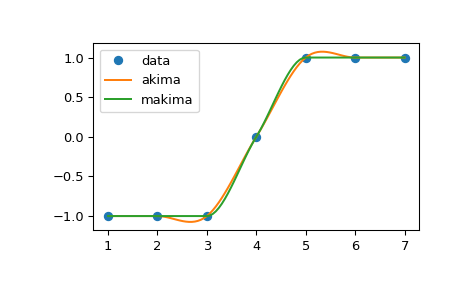Akima1DInterpolator#
- class scipy.interpolate.Akima1DInterpolator(x, y, axis=0, *, method='akima', extrapolate=None)[source]#
Akima “视觉上令人满意”的插值器 (C1 平滑)。
给定向量 x 和 y,拟合分段三次多项式。Akima 插值方法使用由分段三次多项式构建的连续可微子样条。生成的曲线将通过给定数据点,并显得平滑自然。
- 参数:
- xndarray,形状 (npoints, )
单调递增实数值的一维数组。
- yndarray,形状 (…, npoints, …)
实数值的 N 维数组。
y沿插值轴的长度必须等于x的长度。使用axis参数选择插值轴。- axisint,可选
y数组中与 x 坐标值对应的轴。默认为axis=0。- method{‘akima’, ‘makima’},可选
如果为
"makima",使用修改后的 Akima 插值 [2]。默认为"akima",使用 Akima 插值 [1]。在版本 1.13.0 中新增。
- extrapolate{bool, None},可选
如果为布尔值,则根据第一个和最后一个区间确定是否外推到超出边界的点,或返回 NaNs。如果为 None,
extrapolate将设置为 False。
- 属性:
- axis
- c
- extrapolate
- x
方法
__call__(x[, nu, extrapolate])评估分段多项式或其导数。
derivative([nu])构造表示导数的新分段多项式。
antiderivative([nu])构造表示反导数的新分段多项式。
integrate(a, b[, extrapolate])计算分段多项式的定积分。
solve([y, discontinuity, extrapolate])找到方程
pp(x) == y的实数解。roots([discontinuity, extrapolate])找到分段多项式的实数根。
另请参阅
PchipInterpolatorPCHIP 一维单调三次插值器。
CubicSpline三次样条数据插值器。
PPoly分段多项式,以系数和断点表示
备注
在版本 0.14 中新增。
仅用于精确数据,因为拟合曲线精确通过给定点。此例程适用于通过少量给定点绘制一条平滑美观的曲线,以供绘图之用。
令 \(\delta_i = (y_{i+1} - y_i) / (x_{i+1} - x_i)\) 为区间 \(\left[x_i, x_{i+1}\right)\) 的斜率。Akima 在 \(x_i\) 处的导数定义为
\[d_i = \frac{w_1}{w_1 + w_2}\delta_{i-1} + \frac{w_2}{w_1 + w_2}\delta_i\]在 Akima 插值 [1] (
method="akima") 中,权重为\[\begin{split}\begin{aligned} w_1 &= |\delta_{i+1} - \delta_i| \\ w_2 &= |\delta_{i-1} - \delta_{i-2}| \end{aligned}\end{split}\]在修改后的 Akima 插值 [2] (
method="makima") 中,为了消除过冲并避免分子和分母都为 0 的边界情况,权重修改如下\[\begin{split}\begin{align*} w_1 &= |\delta_{i+1} - \delta_i| + |\delta_{i+1} + \delta_i| / 2 \\ w_2 &= |\delta_{i-1} - \delta_{i-2}| + |\delta_{i-1} + \delta_{i-2}| / 2 \end{align*}\end{split}\]参考文献
[1] (1,2)一种基于局部过程的插值和平滑曲线拟合新方法。Hiroshi Akima, J. ACM, 1970年10月, 17(4), 589-602。 DOI:10.1145/321607.321609
[2] (1,2)Makima 分段三次插值。Cleve Moler 和 Cosmin Ionita, 2019。 https://blogs.mathworks.com/cleve/2019/04/29/makima-piecewise-cubic-interpolation/
示例
method="akima"和method="makima"的比较>>> import numpy as np >>> from scipy.interpolate import Akima1DInterpolator >>> import matplotlib.pyplot as plt >>> x = np.linspace(1, 7, 7) >>> y = np.array([-1, -1, -1, 0, 1, 1, 1]) >>> xs = np.linspace(min(x), max(x), num=100) >>> y_akima = Akima1DInterpolator(x, y, method="akima")(xs) >>> y_makima = Akima1DInterpolator(x, y, method="makima")(xs)
>>> fig, ax = plt.subplots() >>> ax.plot(x, y, "o", label="data") >>> ax.plot(xs, y_akima, label="akima") >>> ax.plot(xs, y_makima, label="makima") >>> ax.legend() >>> fig.show()
"akima"中出现的过冲在"makima"中已避免。